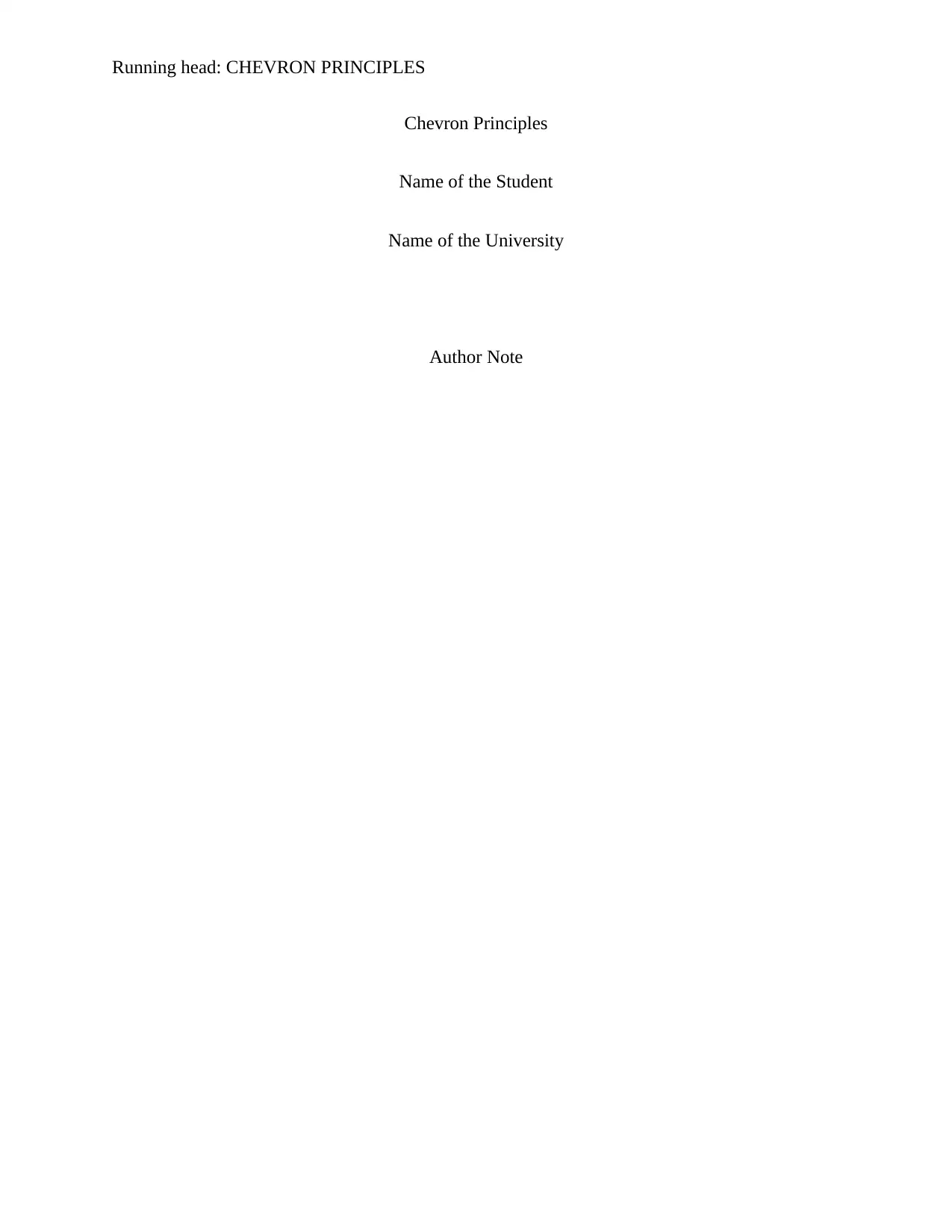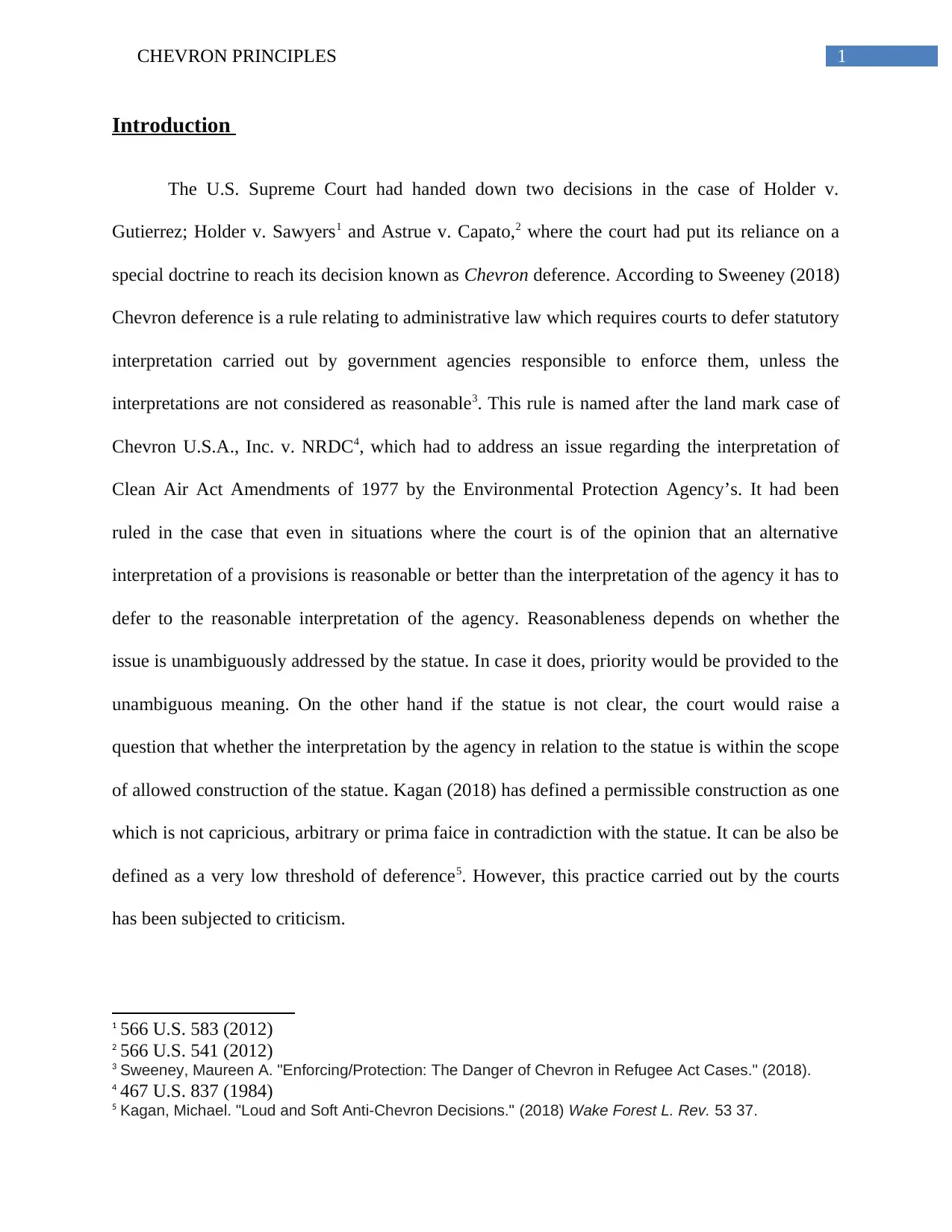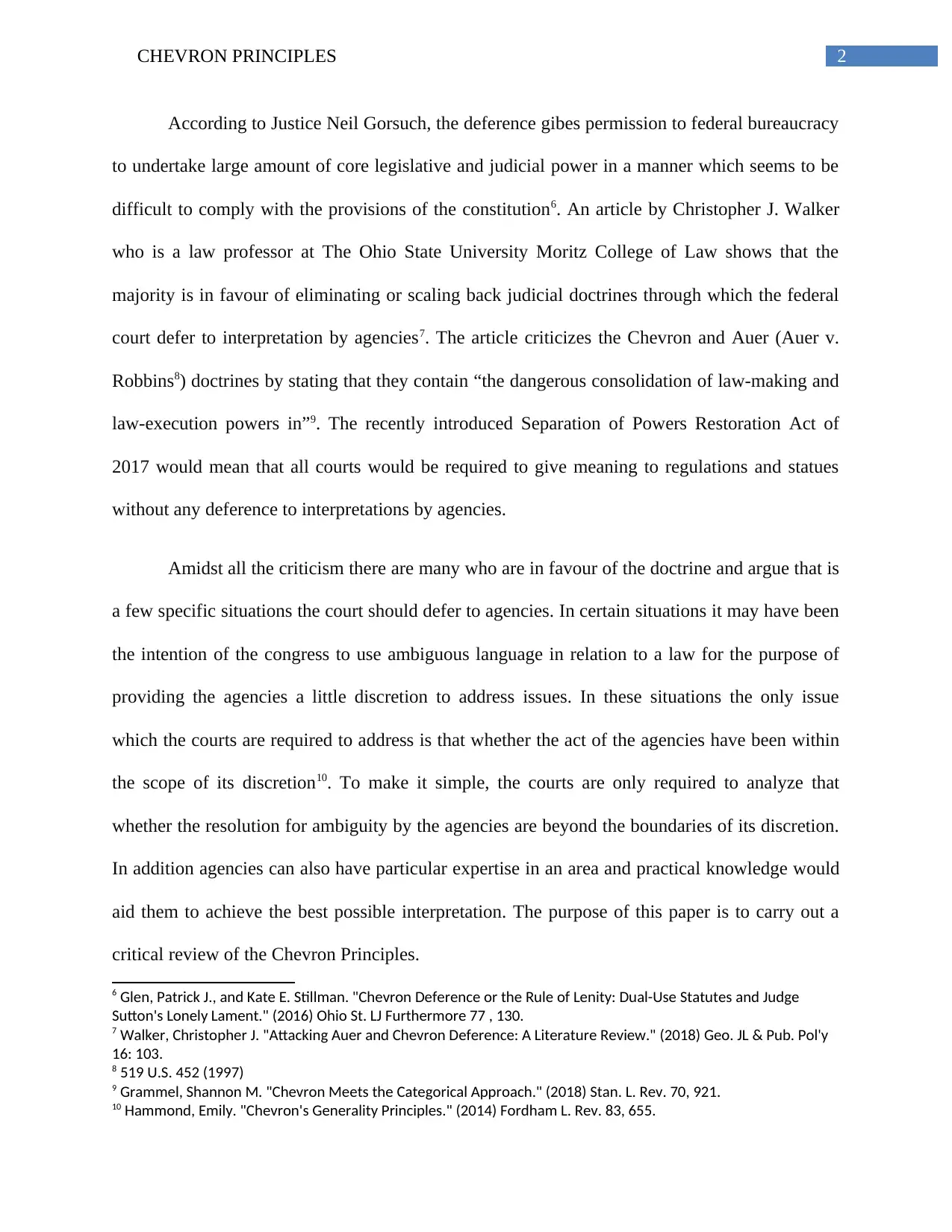Chevron Principles: Deference to Agency Interpretations in Law
VerifiedAdded on 2023/06/03
|4
|837
|252
Essay
AI Summary
This essay provides a critical review of the Chevron Principles, a doctrine in US administrative law where courts defer to government agencies' statutory interpretations if reasonable. Originating from Chevron U.S.A., Inc. v. NRDC, it allows agency interpretations even if the court prefers an alternative. While proponents argue it respects congressional intent and agency expertise, critics like Justice Gorsuch claim it grants excessive power to the bureaucracy, challenging constitutional separation of powers. The Separation of Powers Restoration Act of 2017 aimed to eliminate such deference. The essay explores both sides, analyzing the balance between judicial oversight and administrative discretion in legal interpretation.

Running head: CHEVRON PRINCIPLES
Chevron Principles
Name of the Student
Name of the University
Author Note
Chevron Principles
Name of the Student
Name of the University
Author Note
Paraphrase This Document
Need a fresh take? Get an instant paraphrase of this document with our AI Paraphraser

1CHEVRON PRINCIPLES
Introduction
The U.S. Supreme Court had handed down two decisions in the case of Holder v.
Gutierrez; Holder v. Sawyers1 and Astrue v. Capato,2 where the court had put its reliance on a
special doctrine to reach its decision known as Chevron deference. According to Sweeney (2018)
Chevron deference is a rule relating to administrative law which requires courts to defer statutory
interpretation carried out by government agencies responsible to enforce them, unless the
interpretations are not considered as reasonable3. This rule is named after the land mark case of
Chevron U.S.A., Inc. v. NRDC4, which had to address an issue regarding the interpretation of
Clean Air Act Amendments of 1977 by the Environmental Protection Agency’s. It had been
ruled in the case that even in situations where the court is of the opinion that an alternative
interpretation of a provisions is reasonable or better than the interpretation of the agency it has to
defer to the reasonable interpretation of the agency. Reasonableness depends on whether the
issue is unambiguously addressed by the statue. In case it does, priority would be provided to the
unambiguous meaning. On the other hand if the statue is not clear, the court would raise a
question that whether the interpretation by the agency in relation to the statue is within the scope
of allowed construction of the statue. Kagan (2018) has defined a permissible construction as one
which is not capricious, arbitrary or prima faice in contradiction with the statue. It can be also be
defined as a very low threshold of deference5. However, this practice carried out by the courts
has been subjected to criticism.
1 566 U.S. 583 (2012)
2 566 U.S. 541 (2012)
3 Sweeney, Maureen A. "Enforcing/Protection: The Danger of Chevron in Refugee Act Cases." (2018).
4 467 U.S. 837 (1984)
5 Kagan, Michael. "Loud and Soft Anti-Chevron Decisions." (2018) Wake Forest L. Rev. 53 37.
Introduction
The U.S. Supreme Court had handed down two decisions in the case of Holder v.
Gutierrez; Holder v. Sawyers1 and Astrue v. Capato,2 where the court had put its reliance on a
special doctrine to reach its decision known as Chevron deference. According to Sweeney (2018)
Chevron deference is a rule relating to administrative law which requires courts to defer statutory
interpretation carried out by government agencies responsible to enforce them, unless the
interpretations are not considered as reasonable3. This rule is named after the land mark case of
Chevron U.S.A., Inc. v. NRDC4, which had to address an issue regarding the interpretation of
Clean Air Act Amendments of 1977 by the Environmental Protection Agency’s. It had been
ruled in the case that even in situations where the court is of the opinion that an alternative
interpretation of a provisions is reasonable or better than the interpretation of the agency it has to
defer to the reasonable interpretation of the agency. Reasonableness depends on whether the
issue is unambiguously addressed by the statue. In case it does, priority would be provided to the
unambiguous meaning. On the other hand if the statue is not clear, the court would raise a
question that whether the interpretation by the agency in relation to the statue is within the scope
of allowed construction of the statue. Kagan (2018) has defined a permissible construction as one
which is not capricious, arbitrary or prima faice in contradiction with the statue. It can be also be
defined as a very low threshold of deference5. However, this practice carried out by the courts
has been subjected to criticism.
1 566 U.S. 583 (2012)
2 566 U.S. 541 (2012)
3 Sweeney, Maureen A. "Enforcing/Protection: The Danger of Chevron in Refugee Act Cases." (2018).
4 467 U.S. 837 (1984)
5 Kagan, Michael. "Loud and Soft Anti-Chevron Decisions." (2018) Wake Forest L. Rev. 53 37.

2CHEVRON PRINCIPLES
According to Justice Neil Gorsuch, the deference gibes permission to federal bureaucracy
to undertake large amount of core legislative and judicial power in a manner which seems to be
difficult to comply with the provisions of the constitution6. An article by Christopher J. Walker
who is a law professor at The Ohio State University Moritz College of Law shows that the
majority is in favour of eliminating or scaling back judicial doctrines through which the federal
court defer to interpretation by agencies7. The article criticizes the Chevron and Auer (Auer v.
Robbins8) doctrines by stating that they contain “the dangerous consolidation of law-making and
law-execution powers in”9. The recently introduced Separation of Powers Restoration Act of
2017 would mean that all courts would be required to give meaning to regulations and statues
without any deference to interpretations by agencies.
Amidst all the criticism there are many who are in favour of the doctrine and argue that is
a few specific situations the court should defer to agencies. In certain situations it may have been
the intention of the congress to use ambiguous language in relation to a law for the purpose of
providing the agencies a little discretion to address issues. In these situations the only issue
which the courts are required to address is that whether the act of the agencies have been within
the scope of its discretion10. To make it simple, the courts are only required to analyze that
whether the resolution for ambiguity by the agencies are beyond the boundaries of its discretion.
In addition agencies can also have particular expertise in an area and practical knowledge would
aid them to achieve the best possible interpretation. The purpose of this paper is to carry out a
critical review of the Chevron Principles.
6 Glen, Patrick J., and Kate E. Stillman. "Chevron Deference or the Rule of Lenity: Dual-Use Statutes and Judge
Sutton's Lonely Lament." (2016) Ohio St. LJ Furthermore 77 , 130.
7 Walker, Christopher J. "Attacking Auer and Chevron Deference: A Literature Review." (2018) Geo. JL & Pub. Pol'y
16: 103.
8 519 U.S. 452 (1997)
9 Grammel, Shannon M. "Chevron Meets the Categorical Approach." (2018) Stan. L. Rev. 70, 921.
10 Hammond, Emily. "Chevron's Generality Principles." (2014) Fordham L. Rev. 83, 655.
According to Justice Neil Gorsuch, the deference gibes permission to federal bureaucracy
to undertake large amount of core legislative and judicial power in a manner which seems to be
difficult to comply with the provisions of the constitution6. An article by Christopher J. Walker
who is a law professor at The Ohio State University Moritz College of Law shows that the
majority is in favour of eliminating or scaling back judicial doctrines through which the federal
court defer to interpretation by agencies7. The article criticizes the Chevron and Auer (Auer v.
Robbins8) doctrines by stating that they contain “the dangerous consolidation of law-making and
law-execution powers in”9. The recently introduced Separation of Powers Restoration Act of
2017 would mean that all courts would be required to give meaning to regulations and statues
without any deference to interpretations by agencies.
Amidst all the criticism there are many who are in favour of the doctrine and argue that is
a few specific situations the court should defer to agencies. In certain situations it may have been
the intention of the congress to use ambiguous language in relation to a law for the purpose of
providing the agencies a little discretion to address issues. In these situations the only issue
which the courts are required to address is that whether the act of the agencies have been within
the scope of its discretion10. To make it simple, the courts are only required to analyze that
whether the resolution for ambiguity by the agencies are beyond the boundaries of its discretion.
In addition agencies can also have particular expertise in an area and practical knowledge would
aid them to achieve the best possible interpretation. The purpose of this paper is to carry out a
critical review of the Chevron Principles.
6 Glen, Patrick J., and Kate E. Stillman. "Chevron Deference or the Rule of Lenity: Dual-Use Statutes and Judge
Sutton's Lonely Lament." (2016) Ohio St. LJ Furthermore 77 , 130.
7 Walker, Christopher J. "Attacking Auer and Chevron Deference: A Literature Review." (2018) Geo. JL & Pub. Pol'y
16: 103.
8 519 U.S. 452 (1997)
9 Grammel, Shannon M. "Chevron Meets the Categorical Approach." (2018) Stan. L. Rev. 70, 921.
10 Hammond, Emily. "Chevron's Generality Principles." (2014) Fordham L. Rev. 83, 655.
⊘ This is a preview!⊘
Do you want full access?
Subscribe today to unlock all pages.

Trusted by 1+ million students worldwide

3CHEVRON PRINCIPLES
1 out of 4
Your All-in-One AI-Powered Toolkit for Academic Success.
+13062052269
info@desklib.com
Available 24*7 on WhatsApp / Email
![[object Object]](/_next/static/media/star-bottom.7253800d.svg)
Unlock your academic potential
Copyright © 2020–2025 A2Z Services. All Rights Reserved. Developed and managed by ZUCOL.


